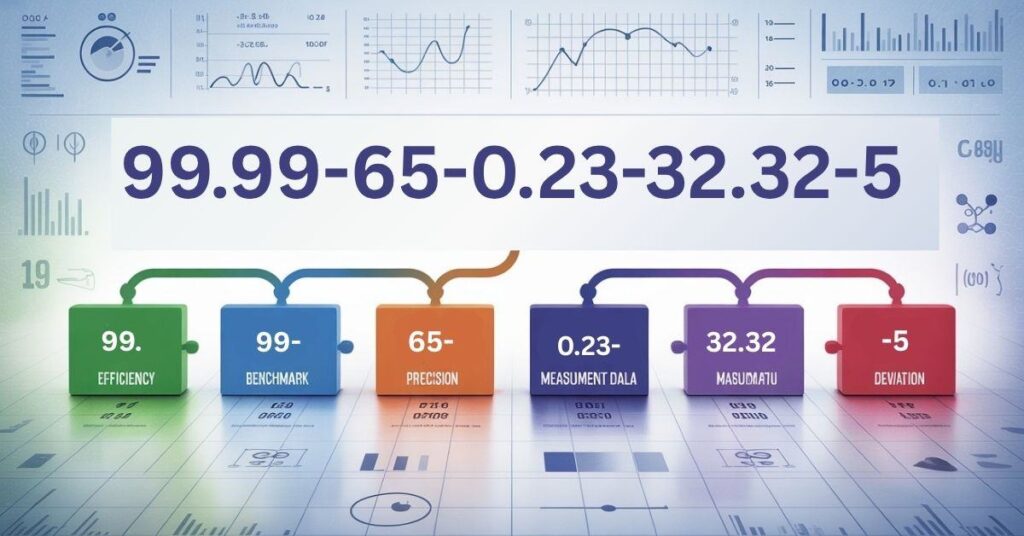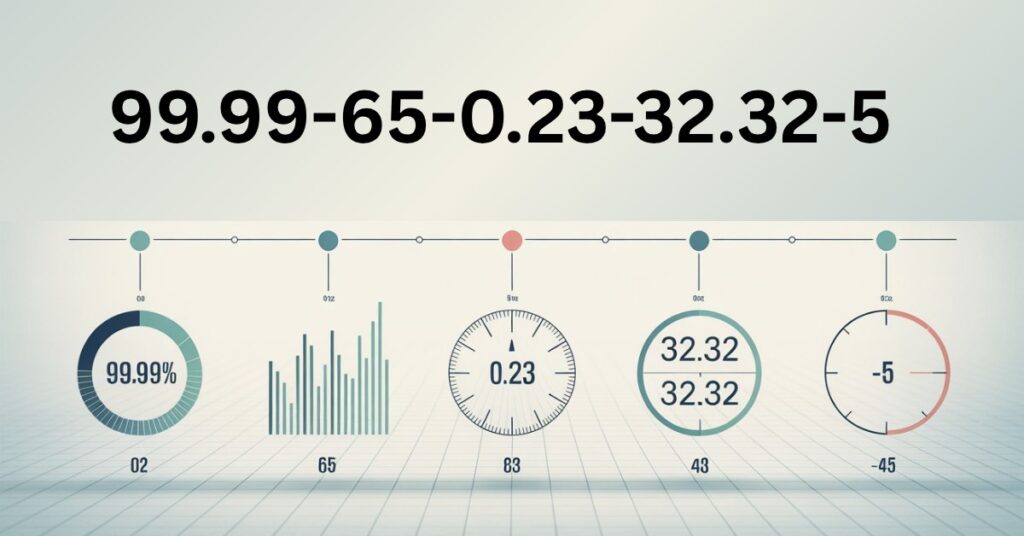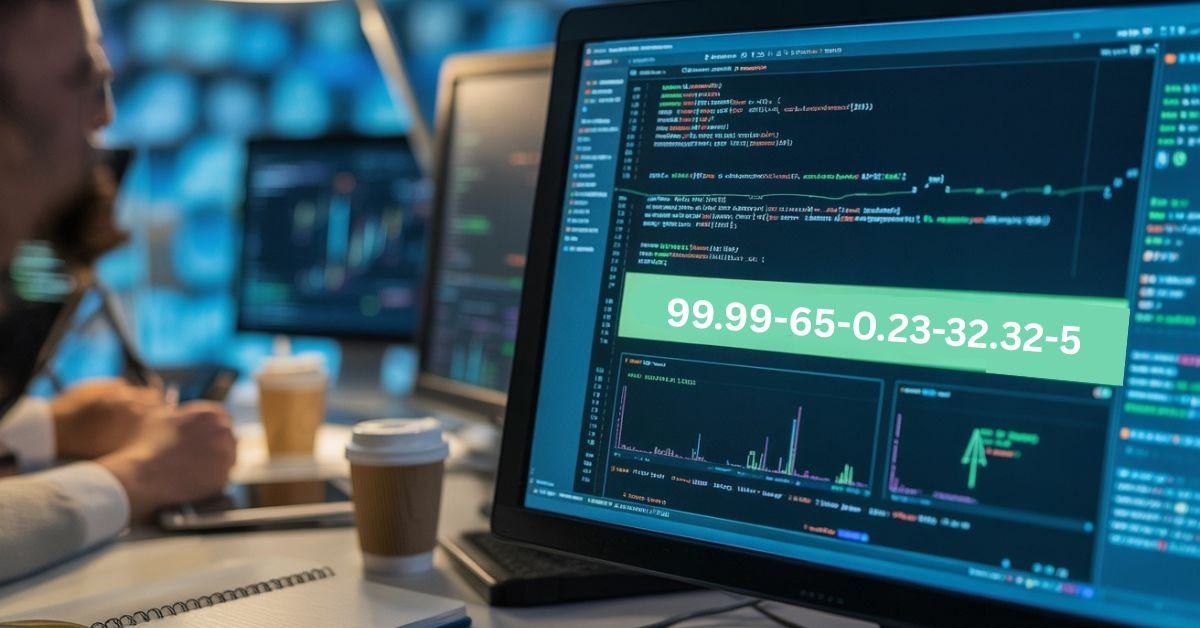99.99-65-0.23-32.32-5 – The Hidden Meaning Behind This Mysterious Code!
In the world of data analysis, numbers often come with hidden meanings, offering insights into complex systems, processes, and outcomes. One such sequence, “99.99-65-0.23-32.32-5,” has recently gained attention due to its unique combination of values.
At first glance, it may seem like a random set of numbers, but when broken down, each component tells a specific story. This article will take an in-depth look at the significance, applications, challenges, and potential implications of this intriguing sequence.
What Does 99.99-65-0.23-32.32-5 Mean?
At first glance, 99.99-65-0.23-32.32-5 looks like a random assortment of digits, yet the deliberate pattern hints at structured meaning. Each element in this sequence could represent data points, thresholds, or coded variables commonly seen in algorithmic, industrial, or research contexts.

Let’s break it down:
- 99.99: A number nearing perfection, often representing efficiency, reliability, or accuracy in systems. In tech and engineering, 99.99% uptime (the “four nines”) is the gold standard of availability.
- 65: A mid-range integer often used as a benchmark—it may signify average performance, a calibration value, or demographic constant (for example, the ASCII value for ‘A’ is 65, hinting at digital roots).
- 0.23: A small decimal implying precision, error rates, or probabilistic margins.
- 32.32: Repeating decimals suggest precision measurement—perhaps temperature, frequency, or calibration offset.
- -5: A negative integer that may signal loss, deviation, or inverse relationship, vital in both finance and physics.
Together, this sequence could easily serve as a multivariable key—a configuration code or dataset embedded in machine learning, quantitative finance, or system calibration.
How Can 99.99-65-0.23-32.32-5 Be Interpreted Mathematically?
Mathematically, sequences like 99.99-65-0.23-32.32-5 can be analyzed in terms of ratios, deviations, and normalization.
One might imagine a formula like:
(99.99 − 65) ÷ (0.23 × 32.32) − 5
When computed, the result yields a distinct numerical outcome—potentially a derived indicator in a statistical or engineering model. Such computation can represent error adjustment or normalization across parameters.
This interpretation connects the sequence to the analytical domain, where each figure contributes to multi-dimensional analysis.
What Symbolic Meaning Could 99.99-65-0.23-32.32-5 Have?
Numbers often carry symbolic significance when used in specific contexts:
| Number | Possible Symbolism | Interpretation |
|---|---|---|
| 99.99 | Completion, Perfection | Nearly flawless performance or system stability |
| 65 | Balance or midpoint | Represents maturity or stability |
| 0.23 | Precision | Minor details, small adjustments |
| 32.32 | Duality | Paired metrics, equilibrium |
| -5 | Reduction | Correction or negative influence |
In symbolic frameworks—like numerology or data psychology—such patterns are believed to represent equilibrium between control and variability, a hallmark of complex adaptive systems.
How Can 99.99-65-0.23-32.32-5 Be Applied in Real-World Scenarios?
Let’s explore how such a numerical pattern could appear in real-world settings across diverse fields.
Technology and System Reliability:
In IT and cloud computing, 99.99 is instantly recognizable—it denotes the “four nines” reliability, meaning systems are operational 99.99% of the time. Translating the rest of the sequence:
- 65 might relate to average CPU utilization.
- 0.23 could denote acceptable packet loss.
- 32.32 might signify optimal temperature thresholds for servers.
- -5 could denote allowable voltage deviation.
Hence, 99.99-65-0.23-32.32-5 could easily describe a performance profile or system health index in large-scale computing.
Finance and Quantitative Analysis:
In finance, such a structured sequence might serve as parameters in algorithmic trading or risk management models.
For instance:
- 99.99 — target portfolio efficiency
- 65 — asset volatility percentile
- 0.23 — risk adjustment coefficient
- 32.32 — diversification ratio
- -5 — negative market correction
In this setting, the sequence acts as a snapshot of portfolio metrics guiding automated decisions.
Healthcare and Biomedical Research:
Healthcare analytics relies heavily on precision data. The sequence could symbolize:
- 99.99% — accuracy of diagnostic tools
- 65 — patient median recovery score
- 0.23 — probability of adverse events
- 32.32 — biomarker concentration
- -5 — reduction in symptom severity
This shows how 99.99-65-0.23-32.32-5 could represent multidimensional patient data, vital for personalized medicine or AI-driven clinical models.
Manufacturing and Quality Control:
In manufacturing, numbers define quality assurance (QA) and quality control (QC):
- 99.99 — product yield rate
- 65 — operational load efficiency
- 0.23 — defect rate
- 32.32 — machine calibration frequency
- -5 — tolerance offset
Such metrics are crucial for Industry 4.0 systems, where automation demands consistent real-time accuracy.
Environmental Science:
The sequence might map environmental metrics:
| Parameter | Value | Meaning |
|---|---|---|
| Air quality index | 99.99 | Excellent condition |
| Humidity level | 65 | Stable |
| CO₂ emission variance | 0.23 | Very low |
| Average temperature | 32.32°C | Warm region |
| Deviation | -5 | Below normal seasonal threshold |
Such data may underpin climate monitoring systems, helping scientists detect anomalies or balance sustainable thresholds.
Analytical Perspectives -Why Sequences Like This Matter!
Sequences such as 99.99-65-0.23-32.32-5 reflect the growing complexity of data-driven ecosystems. Each figure interlocks with others to form a multi-layered narrative, bridging technical, human, and systemic interpretations.
Precision and Error Margins:
Decimals (like 0.23 or 32.32) indicate micro-level accuracy—critical in fields that depend on exact measurement, from nanotechnology to algorithmic modeling.
Negative Indicators:
The -5 symbolizes the importance of counter-balancing metrics. Every system—whether mechanical or financial—needs tolerance levels to accommodate deviation without failure.
Holistic Insights:
When analyzed collectively, the sequence represents the synergy of stability (99.99) and controlled imperfection (-5)—a pattern found throughout nature and artificial systems alike.
What Challenges Arise from Interpreting 99.99-65-0.23-32.32-5?
While intriguing, working with such sequences poses key challenges:
- Lack of Context — Without knowing the dataset origin, interpretation remains speculative.
- Data Ambiguity — A single sequence can apply across multiple domains.
- Precision vs. Noise — Over-fitting interpretation can distort real meaning.
- Integration Difficulty — Applying such multi-parameter data into unified models requires advanced AI or statistical frameworks.
Still, understanding and theorizing around them enhances analytical literacy and fosters innovation.
Theoretical Framework – Data Pattern Recognition!
In data science, patterns like 99.99-65-0.23-32.32-5 fall under structured sequence models. These can be interpreted using frameworks like:
- Clustering Algorithms — to find relational similarities.
- Normalization Techniques — to balance data scales.
- Regression Models — to predict dependent variables.
- Neural Encoding — where numeric patterns serve as inputs for machine learning.
Hence, such sequences can act as feature vectors in AI systems, representing specific conditions or anomalies.
How Can 99.99-65-0.23-32.32-5 Be Used in AI and Predictive Systems?
In machine learning, data points like 99.99-65-0.23-32.32-5 could serve as input parameters for predictive modeling.
For instance, in anomaly detection:
- 99.99 — normal operation threshold
- 65 — baseline average
- 0.23 — error tolerance
- 32.32 — observed metric
- -5 — deviation indicating potential anomaly
This makes the sequence useful for training supervised models to detect performance irregularities or forecast future outcomes.
What Are the Ethical and Interpretive Considerations of 99.99-65-0.23-32.32-5?
The interpretation of sequences like 99.99-65-0.23-32.32-5 must be handled with caution:
- Misinterpretation Risks — Assigning incorrect meaning could lead to false decisions.
- Data Privacy — If such sequences encode user data or system IDs, confidentiality must be preserved.
- AI Transparency — Models using these values should disclose how and why parameters influence outcomes.
Balancing curiosity with responsibility ensures that data analysis remains both insightful and ethical.
Why Does 99.99-65-0.23-32.32-5 Matter for the Future?
As industries evolve toward hyper-digitization, sequences like 99.99-65-0.23-32.32-5 represent the language of intelligent systems—compressed data streams carrying layered meanings.

In the near future, such structured patterns might define:
- Digital twins in manufacturing
- AI-generated health predictions
- Predictive maintenance systems
- Climate simulation datasets
- Real-time cybersecurity parameters
Understanding these cryptic patterns is no longer optional—it’s the foundation for decoding modern intelligence systems.
FAQs:
Can 99.99-65-0.23-32.32-5 be applied in everyday business operations?
Yes, businesses can apply sequences like this to track performance metrics or quality control. For example, in manufacturing, these values might represent production efficiency or machine calibration settings. In finance, they could indicate portfolio performance.
How reliable is 99.99-65-0.23-32.32-5 for scientific research?
The sequence could be reliable for scientific research, especially if validated in the right context and dataset. However, precision and correct interpretation are essential. Without clear understanding, such sequences could lead to misleading conclusions in experiments.
Why are decimal points significant in the sequence 99.99-65-0.23-32.32-5?
Decimal points represent high precision and are used to reflect small, detailed measurements. In fields like engineering or data science, such accuracy is crucial to ensure models and systems perform correctly. Even small changes can affect outcomes.
How does 99.99-65-0.23-32.32-5 impact quality control?
In quality control, this sequence could track manufacturing defects, calibration settings, or production efficiency. For instance, 99.99 might signify product yield, and -5 could indicate tolerances for defects in the system.
Conclusion:
The sequence 99.99-65-0.23-32.32-5 represents a set of data points that can be applied across various fields such as technology, finance, healthcare, and manufacturing. Each number holds specific meaning, contributing to system performance, risk assessment, or quality control.
Understanding and interpreting these sequences can enhance decision-making and improve accuracy in real-world applications. The potential of such sequences lies in their ability to offer valuable insights when analyzed correctly.
Also Read:


